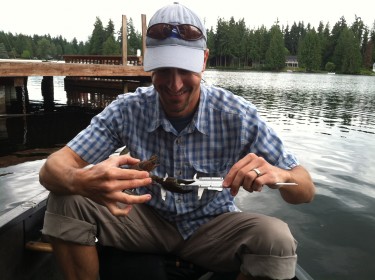
There’s no time like the present for Pine Lake residents—an invasive species of crayfish has taken hold in their backyard and community members are mobilizing to give them the boot. Even though it means setting aside several hours a week during western Washington’s best weather months, these citizen scientists swap their fishing poles for cage traps, hiking boots for clipboards, and swimsuits for scientific instruments to restore the lake’s ecosystem.
Julian Olden, a freshwater ecologist at the College of the Environment and local mudbug expert, recently met with residents of Pine Lake in Sammamish, Wash. to discuss his citizen science program aimed at controlling the red swamp crayfish.
“Citizen scientists are critical to this project,” Olden said. “Without the dedicated and passionate residents of Pine Lake, we would have very little chance of success.”
Native to the southeastern United States and northern Mexico, red swamp crayfish—the most globally invasive of all crayfish varieties—were first discovered at Pine Lake in 2000. Subsequent surveys conducted by Olden’s Freshwater Ecology and Conservation Lab looked at more than 120 lakes in western Washington and found ten more that had been infiltrated by these crustacean invaders.
By reaching sexual maturity more quickly, laying more eggs per female, and exhibiting an aggressive behavior, the red swamp crayfish are often able to outcompete Washington’s only native species, the signal crayfish. Their presence could negatively impact the overall health of the lake and its recreationally important fish.
In 2013 and 2014, Olden trained lakeshore residents to trap, identify, and remove red swamp crayfish from their docks across Pine Lake. Representing the first ever volunteer-based whole-lake removal effort for invasive crayfish, more than 50 households participated, devoting more than 100,000 reported trapping hours, and removing nearly 5,000 red swamp crayfish from the lake. After taking a few measurements and entering their data online, the citizen scientists have a tough decision to make—send them along to Olden and his team to study or bring them home as the centerpiece of a tasty dinner.

Now in its third year, the project brought another dedicated group of households to the 2015 training session. Between May and September, participants will employ their newly honed trapping and research skills to play an important role in the unfolding story of their lake and this invasive species.
Since his first foray into studying crayfish at Pine Lake more than eight years ago, Olden has witnessed the ups and downs in both native and invasive crayfish populations. At a time, there were 12 invasives for every one native. More recently, and for the first time, he observed native signal crayfish occupying areas of shoreline where they’ve never been recorded before and in equal numbers to red swamp crayfish. In the coming years, he and his team hope to determine whether these results could indicate recovery in certain areas of the lake.
Olden believes that the long-term outlook for this lake is bright, noting that complete eradication was never the expectation. Rather, he says, through continued control efforts by a dedicated group, they’re aiming to keep numbers low enough to allow native crayfish and recreational sportfish to achieve sustainable populations in the future.
“The Pine Lake experience serves as an important example for other groups of citizen scientists interested in rolling up their sleeves and tackling the challenge of species invasions. It’s exciting to know that our efforts here have motivated others to think about how they can be involved with invasive species management,” Olden said.

